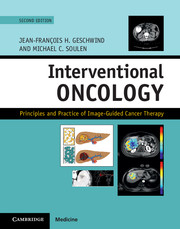Book contents
- Frontmatter
- Contents
- List of contributors
- Section I Principles of oncology
- Section II Principles of image-guided therapies
- Section III Organ-specific cancers – primary liver cancers
- 10 Assessment and triage of hepatocellular carcinoma
- 11 Image-guided ablation of hepatocellular carcinoma
- 12 Embolization of liver tumors: Anatomy
- 13 Conventional chemoembolization and chemoembolization with drug-eluting beads: Technique and future potential
- 14 90Yttrium radioembolization for hepatocellular carcinoma
- 15 Image-guided therapy of intrahepatic cholangiocarcinoma
- Section IV Organ-specific cancers – liver metastases
- Section V Organ-specific cancers – extrahepatic biliary cancer
- Section VI Organ-specific cancers – renal cell carcinoma
- Section VII Organ-specific cancers – chest
- Section VIII Organ-specific cancers – musculoskeletal
- Section IX Organ-specific cancers – prostate
- Section X Specialized interventional techniques in cancer care
- Index
- References
13 - Conventional chemoembolization and chemoembolization with drug-eluting beads: Technique and future potential
from Section III - Organ-specific cancers – primary liver cancers
Published online by Cambridge University Press: 05 September 2016
- Frontmatter
- Contents
- List of contributors
- Section I Principles of oncology
- Section II Principles of image-guided therapies
- Section III Organ-specific cancers – primary liver cancers
- 10 Assessment and triage of hepatocellular carcinoma
- 11 Image-guided ablation of hepatocellular carcinoma
- 12 Embolization of liver tumors: Anatomy
- 13 Conventional chemoembolization and chemoembolization with drug-eluting beads: Technique and future potential
- 14 90Yttrium radioembolization for hepatocellular carcinoma
- 15 Image-guided therapy of intrahepatic cholangiocarcinoma
- Section IV Organ-specific cancers – liver metastases
- Section V Organ-specific cancers – extrahepatic biliary cancer
- Section VI Organ-specific cancers – renal cell carcinoma
- Section VII Organ-specific cancers – chest
- Section VIII Organ-specific cancers – musculoskeletal
- Section IX Organ-specific cancers – prostate
- Section X Specialized interventional techniques in cancer care
- Index
- References
Summary
Background
With increasing incidences, primary liver cancer is already the third most common cause of cancer-related deaths. Most liver cancer patients are diagnosed at intermediate to advanced stages and only 20–30% of them are primarily amendable for potentially curative surgical therapies. This circumstance provides the clinical need for alternative therapeutic approaches that would be able to control the disease with the goal of potentially increasing the overall survival upon diagnosis.
Since the 1970s, catheter-based intra-arterial therapies consistently gained acceptance throughout modern medical science. Nowadays, transarterial approaches constitute a core element of established therapies of liver malignancies. In this regard, conventional transarterial chemoembolization (cTACE) is one of the most frequently used techniques. TACE with drug-eluting beads (DEB-TACE) is a fairly new technique that was presented to the majority of interventional oncologists about 10 years ago. The main objectives of both approaches are to provide therapeutic options for non-resectable patients in order to improve survival and quality of life in a palliative setting, as well as downstaging or bridging and thus making patients amenable for potentially curative surgical treatment. Both cTACE and DEB-TACE exploit the biological characteristic of most hepatic malignancies being supplied by arterial blood. In contrast, healthy liver tissue is mostly supplied through the portal vein. By injecting chemotherapeutic agents into the tumor-feeding vessels, both procedures target tumor tissue while sparing the surrounding liver parenchyma.
In this chapter, we will describe indications, techniques, and complications of cTACE and DEB-TACE and provide the reader with an overview of the scientific rationale. As a conclusion, we will give a brief outlook on future developments.
Concept and materials used during TACE
The general concept of cTACE was introduced in 1977 by Yamada et al., who intra-arterially delivered gelatin sponge pieces permeated with mitomycin C or Adriamycin, after superselecting the tumor-feeding artery of unresectable hepatomas. Nearly 40 years later, the general concept of cTACE remains the same: a mixture of chemotherapeutic agents combined with an oil-based contrast medium (Lipiodol Ultrafluide) is selectively delivered to the tumor-feeding artery. This is followed by a temporary or permanent embolization (Figure 13.1). The dual character of Lipiodol, serving as a drug carrier and an embolizing agent, makes it a key ingredient of cTACE. It is selectively taken up by tumor tissue. Persisting within the tumor for several weeks, Lipiodol embolizes the tumor vasculature up to the capillaries.
- Type
- Chapter
- Information
- Interventional OncologyPrinciples and Practice of Image-Guided Cancer Therapy, pp. 120 - 127Publisher: Cambridge University PressPrint publication year: 2016

